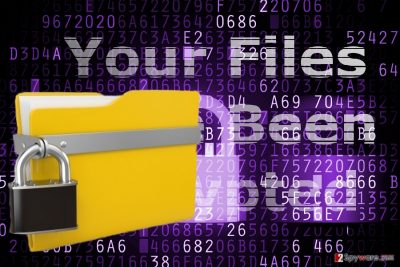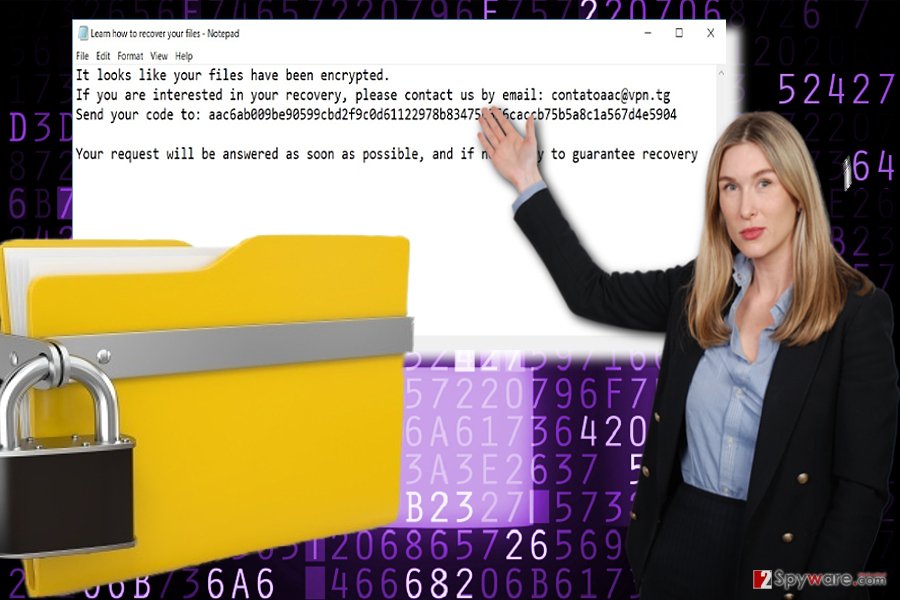AAC ransomware / virus (Free Guide) - Removal Instructions
AAC virus Removal Guide
What is AAC ransomware virus?
AAC ransomware assaults international virtual community

AAC virus is the name of another crypto-malware which encodes data and appends .aac file extension. It seems that the malware in its initial stage of development. What is more, it refers to the Xrat/Xorist family of file-encrypting viruses. It displays Learn how to recover your files.txt file which briefly informs victims about the encrypted files and instructs them to contact the perpetrator via the given contatoaac@vpn.tg email address.
The message says that the file recovery will be guaranteed, however, since the virus is still under development, there are high chances that the decryption process may not go smoothly. It might be the case as with EV ransomware which has faulty decryption procedure. Thus, instead of nurturing hopes of data recovery proceed to AAC virus removal. In this situation, FortectIntego or Malwarebytes might be of assistance.
Ransomware threats keep emerging
This malware is one of recent attempts to extort money from netizens. Interestingly, that though the malware message is displayed in English, it tends to target German users[1]. Though the activity of the malware is still low, multiple security tools can identify it. It disguises under Generic.Ransom.XRatLocker.F09C48DD, Trojan/Win32.SGeneric, Trojan.Encoder.13028 trojan, etc.
While Xorist malware family is quite old, it is still persistent. Recently, its developers seem to be on the move again as multiple new versions rolled out consecutively. Previously, IT experts have created Xorist Decrypter. Therefore, instead of considering paying the ransom, launch the security software. Do not forget to remove AAC malware before you proceed to data recovery procedure. 
Ways to evade crypto-viruses
Since file-encrypting threats spread via multiple channels, you need to apply different prevention measures. Perhaps you already know that spam emails[2] continue to be a popular virus distribution channel. Do not fall into the trap even if you receive the message supposedly sent from the FBI[3] or police department. Such fake messages often contain an attached file with the corrupted payload.
In addition, you should be wary of exploit kits, malicious redirect scripts, rogue apps, extensions and other tools. In order to block the amount of their assault, stay vigilant and scan the device with the set of an anti-virus and malware elimination tools. Likewise, you will be able to lower the possibility of AAC hijack and other ransomware.
Delete AAC ransomware from Windows OS
When it comes to file-encrypting threats, you should not waste time on manual elimination. Let anti-virus tools to handle the infection. After you remove AAC virus with the malware elimination tool, proceed to data recovery methods.
Since meddles with the Command Prompt, AAC removal may not go as planned. In that case, reboot the system into Safe Mode and then launch the security tool.
Getting rid of AAC virus. Follow these steps
Manual removal using Safe Mode
Important! →
Manual removal guide might be too complicated for regular computer users. It requires advanced IT knowledge to be performed correctly (if vital system files are removed or damaged, it might result in full Windows compromise), and it also might take hours to complete. Therefore, we highly advise using the automatic method provided above instead.
Step 1. Access Safe Mode with Networking
Manual malware removal should be best performed in the Safe Mode environment.
Windows 7 / Vista / XP
- Click Start > Shutdown > Restart > OK.
- When your computer becomes active, start pressing F8 button (if that does not work, try F2, F12, Del, etc. – it all depends on your motherboard model) multiple times until you see the Advanced Boot Options window.
- Select Safe Mode with Networking from the list.

Windows 10 / Windows 8
- Right-click on Start button and select Settings.

- Scroll down to pick Update & Security.

- On the left side of the window, pick Recovery.
- Now scroll down to find Advanced Startup section.
- Click Restart now.

- Select Troubleshoot.

- Go to Advanced options.

- Select Startup Settings.

- Press Restart.
- Now press 5 or click 5) Enable Safe Mode with Networking.

Step 2. Shut down suspicious processes
Windows Task Manager is a useful tool that shows all the processes running in the background. If malware is running a process, you need to shut it down:
- Press Ctrl + Shift + Esc on your keyboard to open Windows Task Manager.
- Click on More details.

- Scroll down to Background processes section, and look for anything suspicious.
- Right-click and select Open file location.

- Go back to the process, right-click and pick End Task.

- Delete the contents of the malicious folder.
Step 3. Check program Startup
- Press Ctrl + Shift + Esc on your keyboard to open Windows Task Manager.
- Go to Startup tab.
- Right-click on the suspicious program and pick Disable.

Step 4. Delete virus files
Malware-related files can be found in various places within your computer. Here are instructions that could help you find them:
- Type in Disk Cleanup in Windows search and press Enter.

- Select the drive you want to clean (C: is your main drive by default and is likely to be the one that has malicious files in).
- Scroll through the Files to delete list and select the following:
Temporary Internet Files
Downloads
Recycle Bin
Temporary files - Pick Clean up system files.

- You can also look for other malicious files hidden in the following folders (type these entries in Windows Search and press Enter):
%AppData%
%LocalAppData%
%ProgramData%
%WinDir%
After you are finished, reboot the PC in normal mode.
Remove AAC using System Restore
In case Safe Mode did not help you recover access to the malware elimination tool, perform System Restore. Then, download the tool and remove AAC virus.
-
Step 1: Reboot your computer to Safe Mode with Command Prompt
Windows 7 / Vista / XP- Click Start → Shutdown → Restart → OK.
- When your computer becomes active, start pressing F8 multiple times until you see the Advanced Boot Options window.
-
Select Command Prompt from the list

Windows 10 / Windows 8- Press the Power button at the Windows login screen. Now press and hold Shift, which is on your keyboard, and click Restart..
- Now select Troubleshoot → Advanced options → Startup Settings and finally press Restart.
-
Once your computer becomes active, select Enable Safe Mode with Command Prompt in Startup Settings window.

-
Step 2: Restore your system files and settings
-
Once the Command Prompt window shows up, enter cd restore and click Enter.

-
Now type rstrui.exe and press Enter again..

-
When a new window shows up, click Next and select your restore point that is prior the infiltration of AAC. After doing that, click Next.


-
Now click Yes to start system restore.

-
Once the Command Prompt window shows up, enter cd restore and click Enter.
Bonus: Recover your data
Guide which is presented above is supposed to help you remove AAC from your computer. To recover your encrypted files, we recommend using a detailed guide prepared by 2-spyware.com security experts.If your files are encrypted by AAC, you can use several methods to restore them:
The benefits of Data Recovery Pro
This tool is created for users who want to recover damaged and lost files after a system crash.
- Download Data Recovery Pro;
- Follow the steps of Data Recovery Setup and install the program on your computer;
- Launch it and scan your computer for files encrypted by AAC ransomware;
- Restore them.
AAC Decrypter
Though there is no specific decryption software released particularly for this version, since it still belongs to Xorist malware family, the decrypter might work out.
Finally, you should always think about the protection of crypto-ransomwares. In order to protect your computer from AAC and other ransomwares, use a reputable anti-spyware, such as FortectIntego, SpyHunter 5Combo Cleaner or Malwarebytes
How to prevent from getting ransomware
Choose a proper web browser and improve your safety with a VPN tool
Online spying has got momentum in recent years and people are getting more and more interested in how to protect their privacy online. One of the basic means to add a layer of security – choose the most private and secure web browser. Although web browsers can't grant full privacy protection and security, some of them are much better at sandboxing, HTTPS upgrading, active content blocking, tracking blocking, phishing protection, and similar privacy-oriented features. However, if you want true anonymity, we suggest you employ a powerful Private Internet Access VPN – it can encrypt all the traffic that comes and goes out of your computer, preventing tracking completely.
Lost your files? Use data recovery software
While some files located on any computer are replaceable or useless, others can be extremely valuable. Family photos, work documents, school projects – these are types of files that we don't want to lose. Unfortunately, there are many ways how unexpected data loss can occur: power cuts, Blue Screen of Death errors, hardware failures, crypto-malware attack, or even accidental deletion.
To ensure that all the files remain intact, you should prepare regular data backups. You can choose cloud-based or physical copies you could restore from later in case of a disaster. If your backups were lost as well or you never bothered to prepare any, Data Recovery Pro can be your only hope to retrieve your invaluable files.
- ^ Eliminate malware. Dieviren. Spyware and IT news in German.
- ^ Jana Kasperkevic. The daily grind: Even email spammers work 9 to 5. Marketplace. Marketing News and Insights.
- ^ FBI warns of spreading W-2 email theft scheme. CicagoTribune. Chicago breaking news.





















